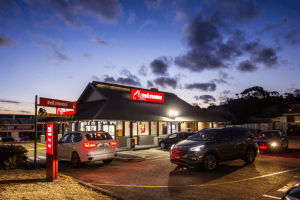
Do you run your business, or does it run you? Are your day-to-day operations a constant struggle? Are you increasingly frustrated? Do you spend more time putting out fires than planning for the future? Remember the day when you started your business. My guess is that you envisioned that being a business owner would allow you more freedom, make you wealthy, and give you the time to pursue your passions like playing golf several times a week? However, if you are like most business owners that have had some success, the complete opposite is often true. When you have some success and have not properly planned for it, your business becomes a time and energy-sucking machine. However, a friend of mine by the name of Laddie Blaskowski who has a consulting company called BusinessTruths shared with me a book he wrote several years ago called “The Step Dynamic” that includes the lessons that make business growth manageable and far less painful.
Recently, I had a client with a very successful child daycare facility. She said that her business had exhausted her current capabilities. She added that she was getting two to three calls a day from new clients that she simply had to put on a waitlist as she could not take on even one more child. She was looking for advice on a strategy for business growth. We discussed the concept of the step dynamic.
The core message of the step dynamic is that as a business grows, its capabilities and sales do not increase linearly. Unfortunately, many business owners think that as you grow, your sales and capabilities increase at a similar rate, as if you were inching your way up the business growth ramp.
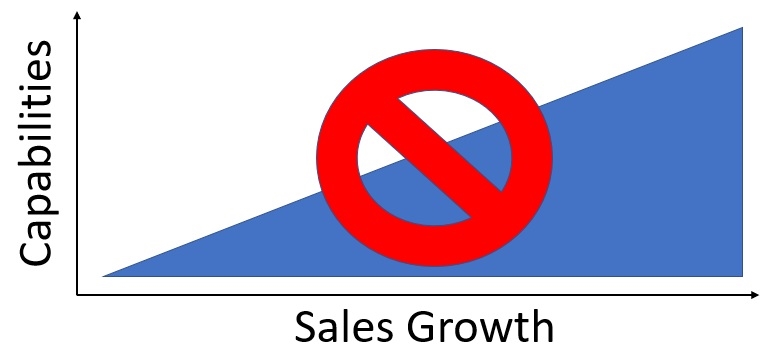
However, a ramp is an incorrect metaphor for business growth. Instead, business growth is more like climbing a staircase. Sales often increase in increments as the business signs new contracts. Moreover, businesses often outgrow their capabilities to service new sales, requiring investment in large blocks to replace existing infrastructure. If business growth is not handled properly, it can often result in catastrophe for the business. This is why successful business owners need to understand the lessons of the step dynamic.
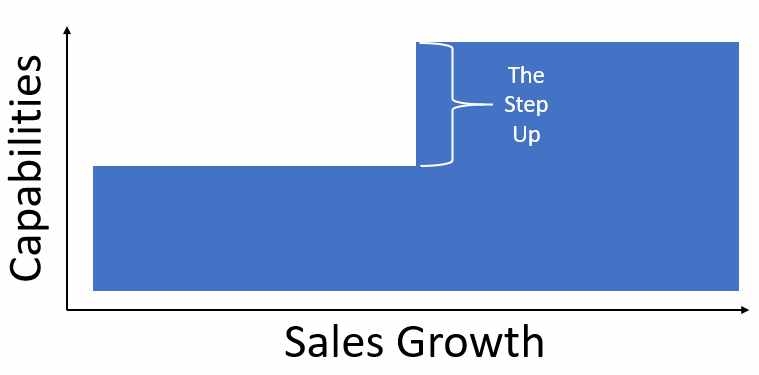
Your company’s capabilities include all the resources that allow your business to operate. Your capabilities do not only include your physical resources such as computers, hardware, vehicles, and office space, but also the systems and controls necessary to manage your business, your ability to market, sell, and support the products or services your business offers, as well as your employees who have to be retrained. Everything that your company needs to conduct business is included when we talk about capabilities.
We all understand that upfront investment is required at the outset of starting a business. For a while, after you open the doors, the business operates below its break-even point and operates at a loss. Eventually, when you have a successful business, growth picks up and sales reach a level where they cover the company’s fixed and variable costs, including those associated with its upfront investments and the business is profitable.
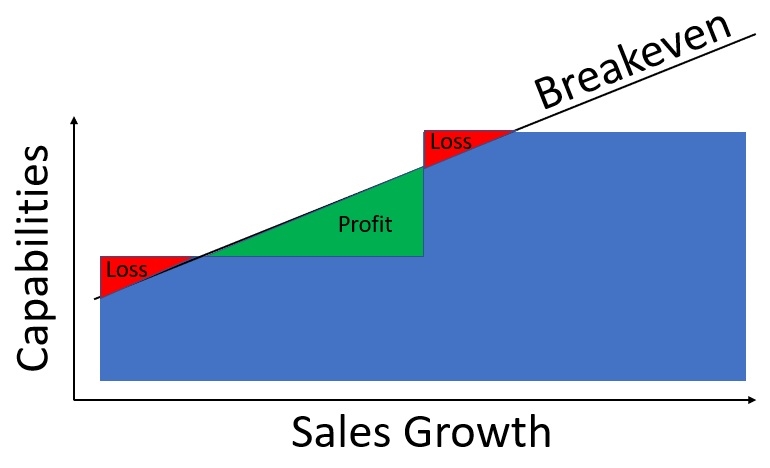
A successful business that is growing can get by with those initial assets for a while. But soon, the successful business begins to outgrow those initial capabilities. As business growth continues, you reach a point where your capabilities are no longer adequate to support your sales volume and the business needs to increase its capabilities.
A business’s need to increase its capabilities does not come gradually. It happens in clusters and that is when the problems with business growth arise.
When I had my documentation and training business, we won a rather substantial contract from a telco company that increased our sales by about 30%. The contract necessitated that we hire ten new employees and purchase new computers and desks so they had a place to work. Since we were almost at full capacity with our current office, we had to lease an additional office suite that was much larger than our immediate needs. The new office space required us to invest in a VPN and add a new phone system as well. Our indirect cost went up as we were forced to increase our capabilities to support this new contract. Moreover, being a services industry, we would work for about 30 days and then bill our customer, who then took another 30 to 45 days to pay us. With additional billings for this single customer amounting to about $ 100k per month, we had to borrow money to cover almost two months of accounts receivable so that we had the cash to cover payroll, rent, and monthly payments on the new equipment. Very quickly, we went from making a profit each month to losing money until sales reached a level to pay for all of our additional capabilities. It was not until years later that I met Laddie and became aware of the step dynamic.
As it turned out, we barely survived our step-up and nearly went bankrupt. Had I known then what I know now about the step dynamic and managing business growth, it would have gone much smoother.
Each time you step-up/increase your capabilities, you drastically increase your overhead which can destroy your business if not managed properly.
To understand how to apply the step dynamic to manage business growth, let’s first examine two common scenarios that businesses often go through when they are not aware of the principles of the step dynamic.
Shooting Past the Step
Too much of a good thing can kill you. Remember that a step defines a business’s capabilities to handle a maximum sales volume. At the beginning of the step, you have more capabilities than you need, costing you more money than you bring in. However, as you continue to grow, sales eventually exceed the break-even point, covering the additional costs of the step-up, and profits flow again from the business. By the time your sales volume takes you to the limit of your capabilities, things begin to break down.
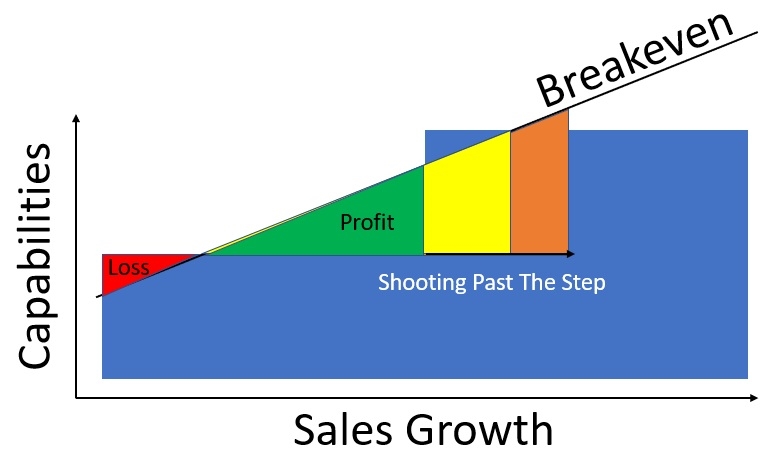
You will find that you and your employees are working a lot more hours per week than before. People make more mistakes when they are overworked. When you are dog tired, you feel pretty much miserable all the time. Many owners fall out of love with their business if they stay in this state. This is known as shooting past the step.
When you shoot past the step, sales have increased beyond your maximum capabilities and you simply don’t have the infrastructure to handle that additional sales volume.
Despite having greater sales, when you shoot past your step, margins drop as you lean on employees to do more, costing you overtime. Overworked people make more mistakes that require additional resources to fix. At that point, having overshot your step, you basically have four options.
1. You can stay put at the point where you are in terms of sales so it does not get any worse. This is always a bad option since you will eventually burn yourself out and learn to hate your business.
2. You can make investments to increase your capabilities. Often, this is not advisable at this time either since you are already overworked having overshot the step. Negotiating a new lease, hiring and training new staff, and raising capital to pay for the step-up takes time and there is no capacity left.
3. You can roll back sales and regroup on the step. This is the most desirable of the four options when you overshoot your step. Rolling back sales and telling customers that you can no longer help them can cause you to lose some clients and damage your reputation. A strategy that works to roll back sales is to raise prices. The higher prices will filter out less loyal and cost-conscious clients so that they leave on their own. Also, raising prices to roll back sales creates less ill will toward you or your business.
4. You can just sell the business. This too is not a desirable option since a buyer will see blood in the water, which drives down your business valuations.
Stepping up too soon
What if you decided to step-up and no one comes? Often a step-up is initiated when the business gets a new flagship client. It may initially feel like you won the lottery when you score a large new client, but it can also mean that if you shoot past your step, you will grow too fast and will have problems. You need adequate time to prepare for each step-up so as not to get caught flat-footed as we did. If, on the other hand, the new flagship client caused you to rapidly absorb much of your capabilities, many business owners see it as an opportunity to do a step-up early in anticipation of similar business growth in the near future.
Staying well within your capabilities after gaining a new flagship customer often causes the business to see an increase in profits for the business owners. Feeling good about the increased profits further causes many business owners to dream big. Not only does it cause many business owners to step-up prematurely, but they also often raise the level of the step too high since they associate increased sales with increased profits. They are often forced to break their lease, paying an early termination penalty to do so and move into more expensive facilities. They replace the used furniture they had when they started the business with expensive new furnishing to match their new digs. They upgrade systems and controls in anticipation of continued success. However, all this comes at a cost. Rather than requiring a marginal increase in sales to surpass break-even, often the distraction in taking the step-up slows the sales growth process as attention is focused on the step-up and not on operations and sales.
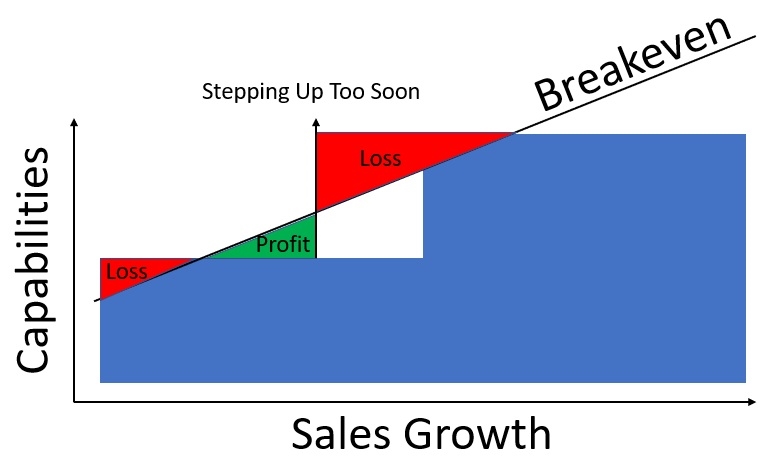
After the step-up, businesses are again losing money each month. When they fail to surpass their break-even for the new step for many months because they stepped up too early, many businesses simply bleed to death before they reestablish profitability.
In my case, the telco client we secured that caused us to step-up pulled the plug on the project about 6 months into a two-year contract. While we were able to secure a few new small clients before the client ended their contract prematurely, we were far from being profitable. Add to that the loss of about 25% of our revenue due to the project cancelation and you can imagine how difficult a situation we were in. It was not like we could simply downsize overnight. It was like being on a magic carpet ride and then having the rug pulled out from under you. Had it not been for a legal settlement, that bought us time to ramp up sales enough to hit our break-even on the step, we would have gone bankrupt.
Most businesses that step-up too soon run out of cash before they achieve break-even and are faced with two options:
1. Back up, shrink the business and sell off assets, and try to survive. This often involves breaking a lease, laying off employees, and selling off assets at fire-sale prices. Most never come close to recouping their losses. If they manage to remain in the game, few ever make up for the losses.
2. Raise sales to reach the break-even point on the step. This option will require belt-tightening measures and laying off idle and overhead staff employees. For the remaining staff and the owners, this often means adding to their workload and requires them to sell like hell.
In our case, we curtailed the pay for all of the owners for a few months, laid off some of our employees affected by the project cancelation, and paid dearly to hire a new crackerjack salesperson to help us sell our way out of our mess. The motto for our recovery was:
If you going to drive off the cliff leave no skid marks.
It worked out for us but only by the skin of our teeth. Had it not been for the legal settlement that bought us enough time to ramp up sales to surpass our break-even on the step, we would have gone bankrupt.
Next, let us look at how understanding the step dynamic to manage business growth lets you grow responsibly using two other scenarios.
Moving Along the Step
In this scenario, the business capitalizes on its capabilities. For a well-planned execution, each step can be divided into three parts roughly equal to about 1/3 of the length of the entire step.
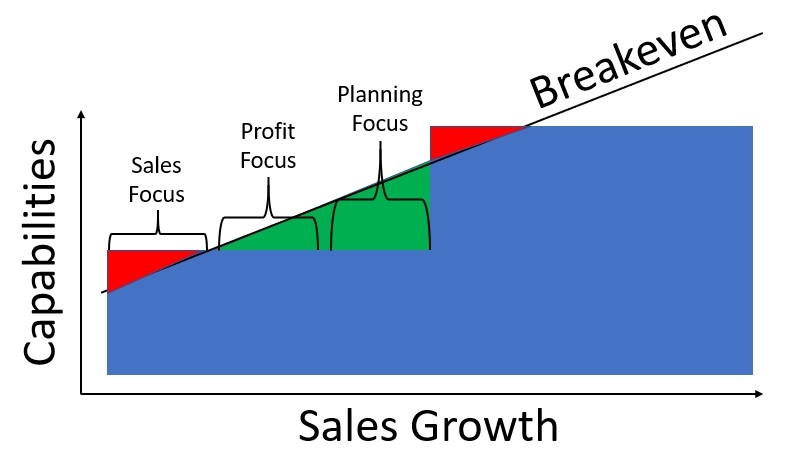
Sales Focus
Part one is at the beginning of the step. At this point, you have more capabilities than sales. With the proper planning, you should not have made the step-up so high that it takes a significant increase in sales to reach break-even. Assuming that you planned for an orderly step-up and were not rushed, causing you to react rather than plan, your first goal, when you begin your journey along the step is to focus on boosting sales. Your business will need the increased sales to generate the revenue to pay for all of your new capabilities associated with the step-up.
Profit Focus
Part two is where you surpass your break-even and you now need to reprioritize your goal from increasing sales to efforts that will increase profitability. The business should look at ways to increase employee efficiency, improve utilization of technology and automation, and improve and streamline your processes. The reason for focusing on profitability at this point is so you can earn enough money to build up reserves, so you’ll have the financial resources to pay for the next step.
So long as you do not have a rival competitor breathing down your neck, forcing you to continue to focus on business growth, many business owners will throttle down sales growth to remain in the sweet spot of the step and enjoy the fruit of their effort. This may also be a time where business owners give themselves a raise. The best part is that the business no longer has cash flow problems which are always quite time-consuming and energy-draining.
Planning
For others not yet satisfied with the size of the business, they will use the final 1/3 of the step for part three and plan for the next step-up.
The Step-Up
In this final scenario to understand the step dynamic, we look at taking your business to the next level with a step-up.
When you’re about 2/3 of the way through your step, you will need to make an important decision about growth. Option number one is that you remain content with the size of your company and stay there for a while as we discussed in step two above. Option two is to use your remaining time on the step to get prepared for the next step-up.
If a step-up makes sense, you need to ask yourself a few questions:
- What increased capabilities will you need?
- What financing will be necessary to achieve your step-up?
- What staffing will be required to operate the larger company?
- Will you need to implement additional systems and controls to manage the new sales level?
Since every step-up involves potential changes to every part of your business, it is critical that you have a plan or you will encounter problems with your step-up implementation. The key is not to wait too long or you risk overshooting the step or moving too fast and stepping up too soon.
You need to put a great deal of thought into the decision to step-up as with each step-up comes additional operational risk. The one really tough question you have to ask yourself is whether you have the knowledge or skills to run a larger company. There are seven stages of business growth that require you, as the business owner, to have different skills. Some owners may consider if it is time to sell the business since they may not have the skills to take the business to the next level. Others may consider hiring another manager to handle the day-to-day operations such as a President while they stay on as CEO.
What I discovered about myself is that I am a visionary with a very dominant personality, skills that make me a good founder and CEO. However, execution is not my strong suit which makes me a poor manager or President. Therefore, I know that I’m great at starting businesses and building them to a point of about 25-30 employees but then it is better for me to either sell the business to someone that has more facilitation skills or to hire a President to focus on the execution.
Making a step-up may require you to add new departments such as human resources and accounting and implement more stringent systems and controls with more sophisticated reporting methods. You may have to bring in contractors and consultants to help with the step-up. You may have to seek additional financing and look for extra space, which takes more time. Often you may need to coordinate a step-up with the end of a lease term. Modifying a new space also takes time, therefore you should plan for it at least six months in advance before you reach the point where you are ready to step-up.
The Step Dynamic Summary
Every business goes through growing pains, but understanding the step dynamic can help make business growth less painful. Business growth is good if it’s handled properly but can be a disaster if not. It basically boils down to making the right decisions at the right time during your journey.
If you believe your company is close to needing a step-up, you need to prepare for it. You can step-up too early or you can wait too long to prepare for the next step and risk overshooting the step. It is all a matter of timing and understanding where your business is at any given time so you can focus on the right things like sales, profits, or planning.
If you shoot past your step and sales surpass your capabilities to deliver, you will feel overwhelmed. Things you had control over when you were a smaller company no longer work like they once did. You will constantly be putting out fires. You will find that things fall through the cracks and find yourself working more and more hours and having no time to do any kind of business planning. Eventually, you burn out and the business dies.
If you have too much of everything except sales, your company has excess capabilities. Excess capabilities cost money and you will find yourself drowning in the expenses of your capabilities. Your equipment sits idle, office equipment is underutilized, the technology you are using may be overkill for your size, you may have employees whose skills are significantly higher than what you need, wasting payroll for overqualified people. By stepping up too early, you risk taking a long time to reach break-even.
How can you apply your knowledge of the step dynamic to manage your business growth?
Business & Finance Articles on Business 2 Community
(60)





